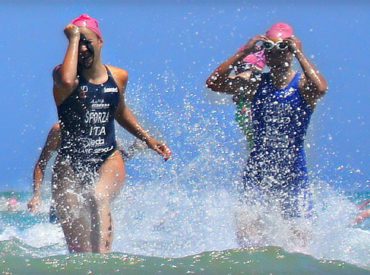Hopefully you are starting to get excited about the idea of committing to an Aquabike race. Perhaps you have even checked out the calendar of upcoming swim + bike events in your area. Maybe, just maybe, you are also starting to evaluate your current fitness so that you can plan your aquabike training plan and how to put it all together. You might also be wondering,
- “How to build up swimming and cycling endurance for an aquabike event?” and
- “How do I know I’ll be ready for race day?
Very good questions.
“Rome wasn’t built in a day.”
One of the best approaches to building endurance for swimming and cycling is to get into a pattern of work plus recovery with the work load gradually increasing as you progress through your training. This is called the Progressive Overload Training Principle.
A key thing to factor into training is time for your body to adapt to unfamiliar movements and physical demands when taking on a new exercise program.
A sedentary person would not do well to jump off the couch and try blasing out a 5 km run. Their lungs would explode, their legs would cramp up and their body would tell them to get lost! Along the same vein, a non-swimmer should not expect to suddenly jump in the pool and be able to swim smoothly non-stop for 30 minutes.
When I first started my swim training, I had to stop to rest almost every lap. But I gradually built up my swimming endurance. I remember how ecstatic I was the first time I found my rhythm and swam non-stop for 2500 meters. It was a happy, proud moment.
Given patience and persistence, you will find your rhythm too.
HOW TO BUILD UP ENDURANCE FOR SWIMMING AND CYCLING?
Try Tammy’s 110% Rule
This rule can be applied to several facets of your aquabike preparation. But firstly, plan to…
Ramp up your exercise output by 10% each week.

I first read this in a triathlon training book years ago and it makes a lot of sense. It even applies to other aspects of new physical movement as well. Katy Bowman, respected Bio Mechanist and author of Move Your DNA, Movement Matters and Whole Body Barefoot, also recommends this incremental approach to adding any new movement into your daily routine.
In regards to building up endurance, consider initiating your training at a level that is comfortable but slightly challenging for you. Use the first week to tweak the level of difficulty up or down so that it feels right for your current condition. Stay at that level for the first week. For the second week, increase your exercise output by 10%. Continue ramping up the demand weekly so that you are putting out 110% effort each consecutive week.
You can do this by;
- Increasing weight training resistance
- Increasing the number of repetitions. For instance if you did 10 reps one week, try 11 reps of the same resistance the next.
- Exercising 10% longer in minutes
- Varying rest breaks
- Swimming and biking 10% farther in distance.
- Increasing speed
I recommend that beginners focus on investing the first few weeks by increasing their exercise duration and distance rather than increasing speed. This will help the joints, muscles, fascia, and other tissues in the body to start adapting to the new demand and build a fitness foundation. Don’t worry, after just a few short weeks, you’ll know when to step on the accelerator.
For instance, let’s say you start your swim training in the pool. For week 1, you plan to warm up for 200 meters and then train for 600 meters. That is 800 meters overall. How far do you swim in week 2? Multiply 800 X 10% = 880. Since lap distances in the pool are fixed, for simplicities sake, we’ll just round up to a full lap or 100m, (For a 50m pool) making it 900m overall.
In fact, I round up or down depending on what makes sense to me at the time. I know that sounds random, but if I am low on energy I might decide to not push myself the extra bit and round down. Likewise, if I am feeling energetic, I will round up and go for a little extra boost.
From week to week, most of my swim training equates to adding 100 meters to the overall distance swum. As you get higher in total distance, say 1500m or more, you can start to add up to 200 meters per week and/ or start ramping up the effort by adding more intensity in speed rather than in longer distances.
HOW DO I KNOW I’LL BE READY FOR RACE DAY?
Tammy’s 110% training rule works here too! Only this time, you are going use it to GO BEYOND.
B. Race Distance + 10%
If your goal is to train for a half ironman distance aquabike which includes a 2km swim + 80km bike you’ll want to go beyond and train for 10% FARTHER.
- 2000 meters x 10% = 2200 meters
- 80 km x 10% = 88 km
“Why?”, you ask.

Because, to put it bluntly, you want to be slightly overprepared for when the shit hits the fan. The “shit” is all of that unpredictable stuff that you can’t plan for; the wind, rain, choppy waters, flat tires, hills or when you aren’t feeling 100% on race day. All of that and more. See “My first half ironman aquabike and rookie mistakes” and learn from my first event experience.
On race day, you don’t want to just barely finish by crawling over the finish line, or worse yet, not finish! You want to finish strong and in your element.
C. Race Time – 10%
Based on your level of skills and fitness, estimate how much time it will take you to complete the race. Make sure you find out if there are any official time limits for completing the swim leg and bike leg of the event, then subtract 10% of the time.
- Let’s say the official time limit to complete a 2km swim + 80km bike ride is 4.75 hours. A new Aquabike athlete just starting out, may be aiming to just finish the race.* In that case, their target is to finish well within the official time limit by training to cross the finish line in 256 minutes (4.26 hours) or less, rather than 285 minutes (4.75 hours).
*True story. When I started training for my first Aquabike in the Rottnest Sufferfest, my main goal was to complete the training and be able to confidently step up to the starting line. Everything after that, I considered, was gravy.
D. Time to Prepare + 10%
*Using the distances from B and the race time from C, plan how long it will take you to get ready for your event + 10%.
- Estimate 20 weeks to get ready + 10% = 22 weeks
Again, this applies to Murphy’s Law. Build in contingency’s. Add extra time for extra rest days and mini breaks from training. Extra time gives you a buffer against “LIFE” distractions that might take you away from training. Say you have a family issue that requires your time and attention or you feel sick for a week or two and can’t train very hard, if at all. In these cases, you will want to have some extra time to make up the training.
Lets bring it all together;
Using Tammy’s 110% Training Rule; you know you’ll be ready for your first half ironman aquabike if you plan to…
- Swim 2.2km + bike 88km.
- FINISH 2.2km + 88km within 256 minutes or 4.26 hours.
- Invest 22 weeks to train and prepare.
- Initiate your training in week 1 and add 10% more effort every week.
Complicated? No, you’re just adding a 10% buffer.
If the 110% rule leaves you confused I can simplify it. Make it TAMMY’S RULE OF 3RDS instead.
This might sound like a crazy analogy, but stick with me.
Have you ever lived through a house remodel or some sort of demolition and construction project?
You know how at the beginning of a remodel you estimate that it will take x amount of time and x amount of money and x amount of stress to complete the job? Uh huh, I know you know. You plan how long it will take, how much money it will cost and how much mental space it will require. You get really excited and want to share it with the world! You get so excited even that you plan ahead and invite guests to a housewarming party to show it off when it is done.
Once you start; however, you discover some unanticipated hiccups and stumbling blocks that impede progress and cause unplanned delays. Before you know it, the remodel is nowhere near ready for the housewarming party. You have to call all of your friends, eat crow and cancel the celebration. When all is said and done, the whole job takes 1/3 longer than you originally planned and your friends have gotten tired of hearing about it.
Guess what?
YOU ARE THE REMODEL AND YOUR RACE IS THE PARTY!
Your project is to get your self race ready and to display your success by stepping up to that starting line with confidence. Your job is to plan for contingencies and get your butt across that finish line. Got it?
How?
PLAN TO GO BEYOND by adding 1/3rd more to the total distance.
Train as if the race were 1/3rd longer than it really is. If the swim is 2000 meters train to swim 2600 meters. If the bike is 80km, train to ride 106. That’s it. Program your training to finish 2600m swim + 106km ride within the official race time limit.
That way you know that you have the strength to absorb whatever comes your way and overcome it.
BooYah!
Let me know how this resonates with you. I’d love to hear a snippet of your journey in the comments below.
Thank you,
Tammy



The way you lay out this plan is something I really believe I can do. It’s gradual steps, so it doesn’t overwhelm me. I’ve been in training before, and it was brutal. The way you explain it with starting slow, gradually adding, in each of the areas, is what I’ve been looking for. I love you site, and I just wanted to pop in and let you know!
Thank you for your lovely words Babsie. You can do it. Take your time and listen to what you and your body need. I’m here if you need help getting started. Thanks for popping in and sharing the love!
Tammy
I can definitely relate to your rule of thirds example with remodeling a house! We remodeled our basement, and that’s exactly the way it was–everything went over by at least a third just because of all the unexpected things we encountered.
My husband and I are starting a new exercise regimen, and I love the 110% rule. We want to create a routine that keeps pushing us, but also increases our stamina in a healthy way so we don’t get discouraged. I don’t know if there are any races in our future, but we know we’re going to be much healthier–thanks for the tips!
Hi Janelle,
Glad to hear it. I know, those remodels can really take it out of you! I hope it all came out beautifully in the end! The key is to stick with your new exercise regimen and be patient and kind with yourselves.
Let me know how you go. Good Luck,
Tammy
Hi, Tammy! I really like this Tammy’s 110% Rule! It’s such a cool way to approach training. And it guarantees the best results during the race.
Your method demands to keep on pushing our limits and I really like that aspect. When I’m training I recognize that a very important part of the process is psychological.
Thank you very much for the analogy with the house remodel project. We have recently gone through one and can relate to this example. 🙂
Hi Henry, thank you. Yes, psychology is so critical. Getting a handle on it in your mental approach and mindset is the only way to succeed. I love the idea of tricking my brain into committing by giving it bite sized chunks to start with. That’s why 10% increases work!
When your motivation is low, try tricking your brain by striking a bargain that gives you an out. Say, “Ok, I don’t really feel up to it today, but I want to give it a go. So I’ll go for x amount and see how I feel. If I still don’t feel it, I’ll turn back.” More often than not, this brain trick will turn into a successful workout.
All the best, Tammy